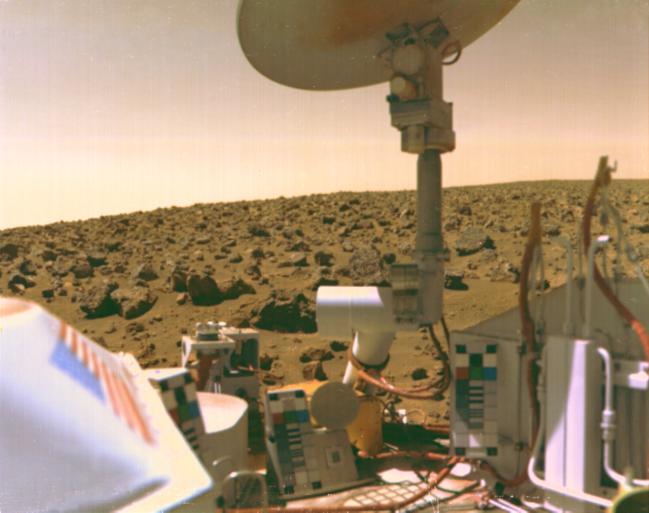
Thirty-three years ago this month, on the seventh anniversary of the first manned lunar landing, Viking I became the first spacecraft to successfully land on the surface of the planet Mars. The primary purpose of the mission was to search for signs of life on the Martian surface.
The Viking I mission began with launch from Earth on Wednesday, 20 August 1975. Lift-off of the Titan IIIE-Centaur launch vehicle from Cape Canaveral, Florida took place at 2122 UTC. The Viking I orbiter-lander payload mass at lift-off was 7,766 lbs.
After chasing Mars for 11 months and 500,000,000 miles, Viking I entered Martian orbit on Saturday, 19 June 1976. The original plan called for a landing on Sunday, 04 July. However, imaging of the intended landing site from orbit revealed that a landing there would be a high risk venture. With this revelation, Viking project scientists went into high stress mode to locate a suitable alternate landing location.
On Tuesday, 20 August 1976, the Viking I lander separated from the Viking orbiter at 0851 UTC in preparation for the deorbit burn.
The Viking I atmospheric deceleration sequence began at roughly 1,000,000 feet above the Martian surface. An ablating aeroshell both slowed and protected the vehicle from aerodynamic heating down to 19,000 feet. At this point, a 52.5-foot diameter parachute was deployed to provide further slowing. At 4,000 feet, the aeroshell and parachute were jettisoned and the craft’s retro-rockets were fired
The Viking I lander touched-down at Chryse Planitia (“Golden Plain” in the Greek) at 1153 UTC having completed the first successful Martian entry, descent, and landing (EDL) mission. The Viking I landing mass was on the order of 1,320 lbs. (Point of clarification: the photo above was taken by Viking II which landed on Mars at Utopia Planitia (“Nowhere Plain”) on Friday, 03 September 1976.)
Viking I went on to perform a variety of first-ever scientific investigations on Mars. Key instrumentation included several cameras, a surface sampler arm, a meterology boom, a seismometer, and a variety of other sensors. In its search for signs of life, Viking I was also configured with an internal biology compartment and gas chromatograph mass spectrometer.
The Viking I lander was designed to function for a minimum of 90 days on the surface of Mars. In reality, it continued to function and provide useful science for over 6 years (contact lost 13 November of 1982). While it rewrote the book in terms of Martian planetary science, Viking I did not in fact discover defintive signs of life on Mars.
